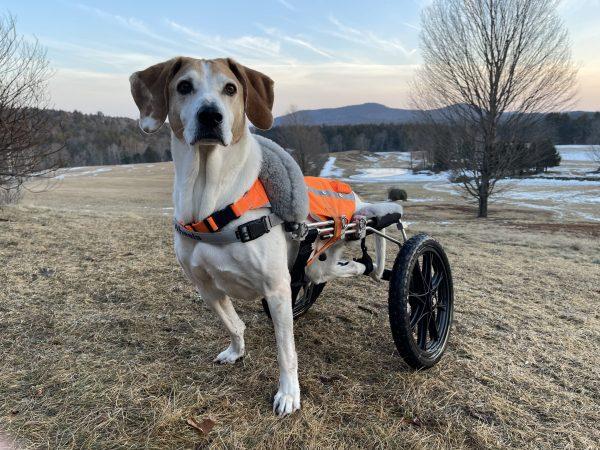-
About
- Leadership & Faculty
- News & Events
-
Academics
- Graduate
- Advanced Clinical Training
- Continuing Education
- Academic Departments
- Academic Offices
- Simulation Experiences
-
Student Life
- Offices
-
Research
-
Hospitals & Clinics
- Emergency Care
- Hospital Services
-
Community Outreach
- Volunteer
Paralyzed Dog’s Bladder Issue Resolved Through Innovative Procedure
Innovative surgery remarkably improves life of Coonhound Balius

Balius, a treeing walker coonhound who is about 8-9 years old, has had a tough life. His left rear leg was amputated following third-degree burn injuries sustained in a fire. He was severely beaten with a blunt object by a previous owner who claimed Balius was hit by a car. The owner left him with a veterinarian and took off. Paralyzed below the L4 vertebrae and reliant upon a wheelchair for mobility, despite these challenges Balius is “very happy and is an amazing dog,” according to his owner.
Nearly five years ago, Balius was adopted by David Kracov, owner of the foundation Wheelchairs No Cares, which donates wheelchairs to families or shelters that cannot afford them. Officials from the shelter where Balius was living decided they could not continue his labor-intensive care and decided to euthanize him. A colleague sent Kracov a picture and asked if he knew of anyone willing to adopt Balius. “That picture was all it took,” recalls Kracov. “But they also shared a video of him playing with a puppy and I said, ‘I’ll take him.’”
Brought to Cummings School’s Foster Hospital for Small Animals in March 2021, he was treated by Dr. Emmanuelle Butty, a Urology/Nephrology Fellow in Small Animal Internal Medicine.
Kracov sought assistance to express Balius’s bladder. After managing the issue medically for three months, they tried two surgical procedures. The first was a foley catheter, a tube originally designed to be inserted into the urethra to empty the bladder, used as a cystostomy tube. But regardless of how well it was sutured, the tube kept getting dislodged. The second attempt was a low-profile gastrostomy tube, originally designed to be inserted into the stomach as a feeding tube, was unsuccessful because it was suctioning the bladder instead of emptying it.
Dr. Butty requested ideas from colleagues and Dr. Raymond Kudej, a Cummings School professor and small animal surgeon, suggested an innovative option—inserting a pleural port into the bladder and enabling his owner to extract urine from it several times each day. “To my knowledge, this had never been reported before,” Dr. Butty claims.
“The pleural port is designed as a way to evacuate chest fluid,” explains Dr. Kudej. “There was a possibility that the urine would leak around the port out of the bladder and get under the skin, which could be toxic. This was an opportunity to possibly gain control of the bladder but decrease the risk of infection because it is a self-contained system. It’s not like the other catheters that went directly from the bladder to the skin where the bacteria from the skin can migrate along the catheter and enter the bladder, resulting in recurrent infections.”
After the first pleural port failed because the dog’s wheelchair was rubbing against it, a second port was installed in mid-December. “It was an excellent idea,” acknowledges Dr. Butty. “The port is under the skin and the owner pokes it with a needle and empties the bladder.”
To date, the exploratory surgery has succeeded, lasting three months with full functionality. “We’ll have to see how long it stays intact, but so far it seems to be doing well,” Dr. Butty reports.
And they may have found a viable option for the future. “People may have thought it would be crazy to try this, but it worked and it’s an option for similar cases moving forward,” Dr. Kudej asserts.
For Kracov, the experience with Cummings School has been fantastic. “My first concern when I started working with Tufts was how well my dogs would be cared for,” shares Kracov. He has three dogs and all use a wheelchair.
Caring for disabled canines carries additional challenges, according to Kracov. “The difficulty with having a disabled dog is that doctors do the surgery but they don’t know how to care for them afterward because that’s not their job,” Kracov laments. “Dr. Butty learned how to care for my dog right next to me and she wanted to learn it – the first doctor I’ve ever had who wanted to do that. Working with Dr. Butty has been incredible. I have nothing but praise.”
Dr. Kudej agrees with Kracov’s assessment of Dr. Butty. “She’s terrific,” he admits. “She is passionate and really cares about her patients and their owners. In that regard, she’s very special.”
The lives of Kracov and his canine companions have improved since their Cummings School treatments. “The personalities of all my dogs have changed for the better,” Kracov explains. “Prior to the surgeries it would take 45–90 minutes to expel Balius’s bladder. I did that four times a day for about four years. Now it takes five minutes, and he usually sleeps while I’m doing it because it’s in the paralyzed part of his body.”
Kracov says that his dogs lead happy and fulfilling lives. “We spend most of our extra time playing and hiking. We do about 10 to 15 miles a day now.” He has a three-legged Belgian Malinois who lost a leg in a suicide bombing in Jerusalem and Miniature Pincher with a titanium rear leg he added following injuries sustained from an abusive previous owner.
“I take the dogs nobody wants,” Kracov shares. “But the way I look at it, every one of them has a sad story but a happy ending.”
Department:
Foster Hospital for Small Animals